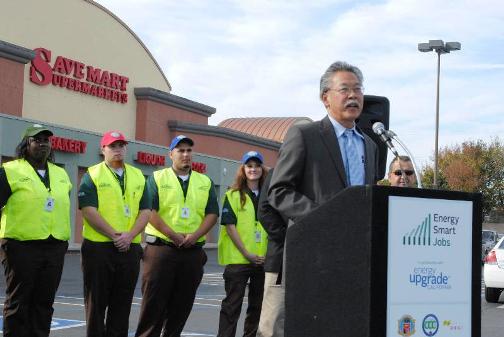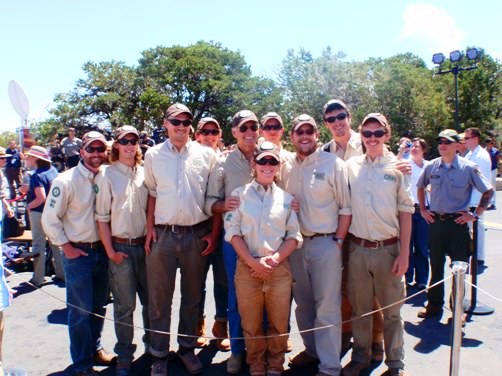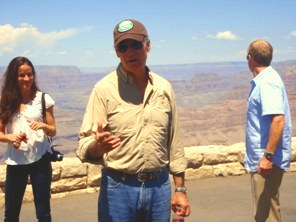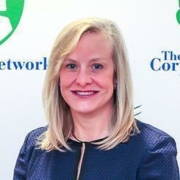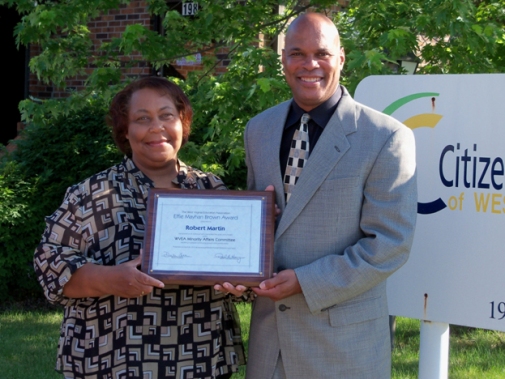
Pictured (left) Linda Pannell, WVEA representative and Robert Martin (right), recipient of the Effie Mayhan Brown Award. Pannell also nominated Martin for this prestigious award.
From the Citizens Conservation Corps of West Virginia
Beckley, WV – Robert A. Martin, Executive Director of the non-profit Citizens Conservation Corps of West Virginia (CCCWV), received the prestigious Effie Mayhan Brown Award at the West Virginia Education Association’s 31st Annual Human Relations Luncheon. The award, presented on April 30, 2010, recognized Martin as an individual who exemplifies the goals and charges of the WVEA Minority Affairs Committee resulting in positive community growth and contributions. Educator Linda Pannell, who teaches at Lester Elementary, nominated Martin for this Volunteer of the Year award due to his unwavering commitment and time devoted to area youth.
For the past several winter ski seasons, Martin has provided ski clothing, equipment, rentals, lift tickets, and lessons for over 20 area youth from Raleigh & Fayette Counties at no cost to the children, ranging from as young as age 5 up to 16. He also made sure that each had transportation to and from Winterplace once a week for approximately 8 weeks during the winter ski season. Linda Pannell also assists Martin by chaperoning the children and helping to coordinate their trips to Winterplace each week. Many of the youth are from Pannell’s church and she has seen the smiles and positive impact that the skiing has had in their lives. “The children are our future leaders of tomorrow–they deserve opportunities and a chance to experience and be exposed to all that our area has to offer”, says Pannell. Robert Martin has taken such a huge interest in these kids and has made them feel like they can conquer and do anything. He does not ask nor expect anything in return – except to make sure the kids have a great time which is why I nominated him”.
Along with Pannell and her husband, Martin’s staff volunteers once a week after work with the children either helping them to ski, or simply assisting with supervision and all of the intangibles it takes to get the children ready for the slopes. None of the youth had ever skied before until Martin extended this opportunity. By the end of the ski season, everyone is skiing on their own and the grand finale is a weekend trip to Snowshoe. The interest and inquiries have increased to where Martin is currently seeking funds and ramping up volunteer recruitment efforts so that he can serve more youth and turn no one away. Plans for a trip out west are also being considered. “We want to expose the children to the best and make sure their experience is both memorable and everlasting. It is also a boost to their self esteem; it mentally and physically challenges you. Plus, it opens their eyes to so much more than just skiing”, says Martin.
Martin has served as the Executive Director of the CCCWV for the past 17 years. Robert is responsible for starting The First Tee of Beckley in 2005, which received its statewide charter in 2009 as The First Tee of West Virginia. TFTWV is a youth-development program that utilizes the game of golf to bring fundamental life skills, core values, and educational experiences to underprivileged youth that might not typically be exposed to the game. Programming seamlessly integrates life skills and nine core values: Honesty, Integrity, Sportsmanship, Respect, Confidence, Responsibility, Perseverance, Courtesy, and Judgment. Many of the same philosophies and core values of The First Tee are being integrated with the skiing program.
Martin, a veteran of the United States Army, has studied at Howard University, Grambling State University and West Virginia University College of Law. He holds a degree in Political Science and English and was selected as one of the “100 Most Outstanding Young Men in America” in 1983. Currently, Robert serves as both member and Board of Director for The Beckley-Raleigh County Chamber of Commerce and Beckley Rotary Club and is Chairman of the Board for The First Tee of West Virginia. Robert is also Chairman of the Beckley Intermodal Gateway (BIG) Steering Committee; and is a member of the Washington, DC-based Intelligent Transportation Systems of America (ITSA); and serves on the West Virginia Citizen Corps Council. Robert also volunteers as a ski instructor for the Challenged Athletes of West Virginia (CAWV), an adaptive sports program for disabled athletes located at Snowshoe.
About CCCWV
Today’s CCCWV are inheritors of the legacy of FDR’s Civilian Conservation Corps; its mission is to conduct projects and programs which strengthen and revitalize our communities; provide self-esteem, educational enhancements and employment opportunities through meaningful work experiences for both youth and adults; and, to conserve, develop, and enhance our state’s natural resources. For more information about the CCCWV, call 304-254-9196 or visit www.cccwv.com.
About WVEA
The West Virginia Education Association, headquartered in Charleston, WV is the state’s largest teachers’ organization. WVEA has been making a difference for over 150 years, providing support for educators and advancing public education in the state. For more information about WVEA, call 1-800-642-8261 or visit www.wvea.org.




